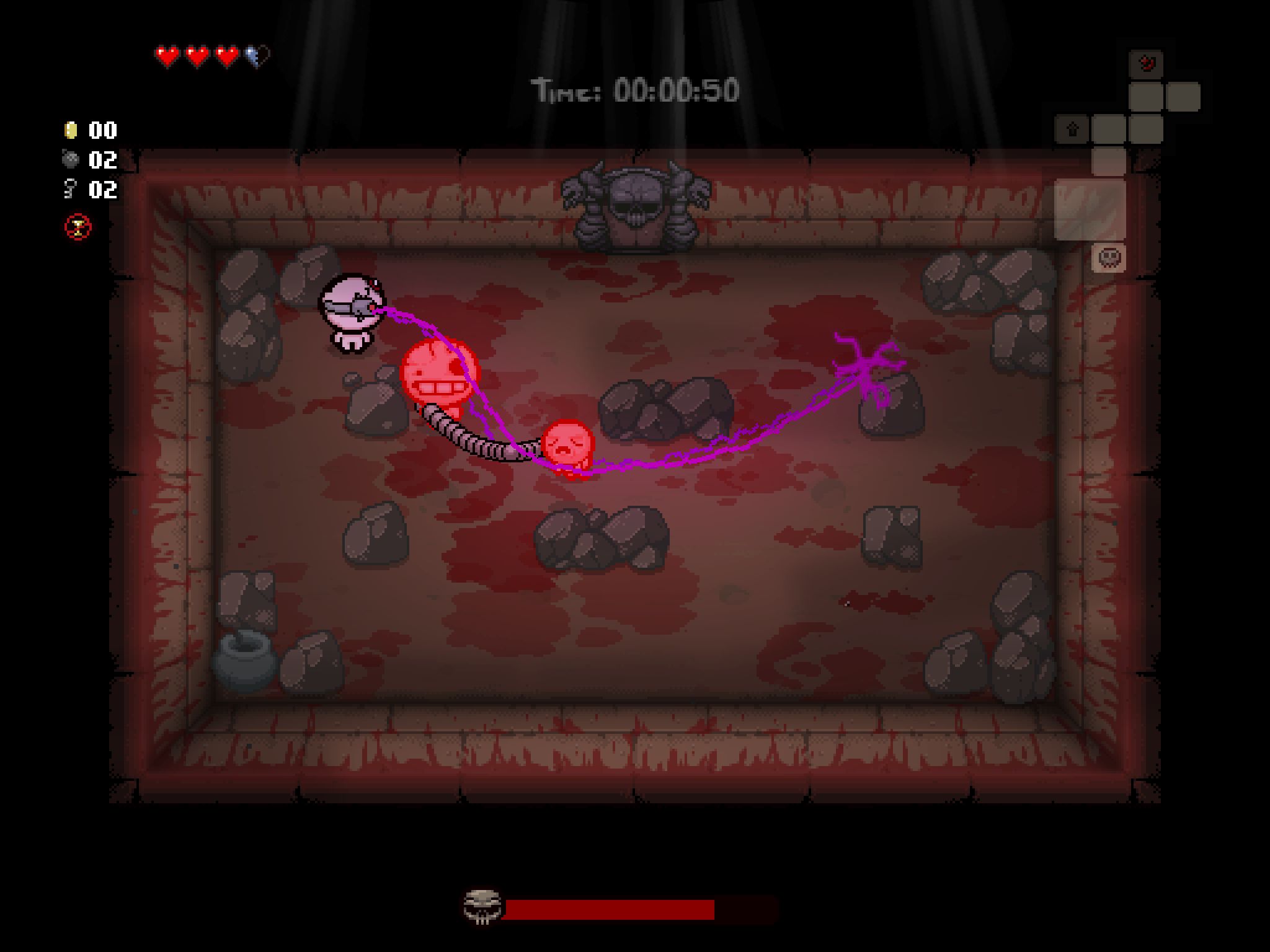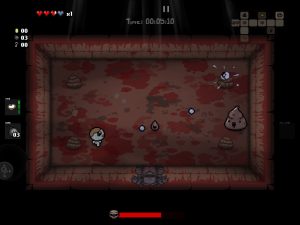 At last! The Binding of Isaac: Rebirth ($14.99) has finally released on iOS, and it was well worth the wait. Perhaps the most popular dual-stick shooter roguelike out there, rumors, Apple approvals drama, and a constantly-shifting release date led to this being the white whale for many iOS gamers. As the release date narrowed down to a general range, every day saw one question surely asked: “When’s Isaac coming?" Well, thanks to a surprise Tuesday night release on January 10th US time, The Binding of Isaac is finally here, and well worth the wait. The scatological, challenging roguelike dual-stick shooter promises challenging gameplay with mountains of secrets to discover.
At last! The Binding of Isaac: Rebirth ($14.99) has finally released on iOS, and it was well worth the wait. Perhaps the most popular dual-stick shooter roguelike out there, rumors, Apple approvals drama, and a constantly-shifting release date led to this being the white whale for many iOS gamers. As the release date narrowed down to a general range, every day saw one question surely asked: “When’s Isaac coming?" Well, thanks to a surprise Tuesday night release on January 10th US time, The Binding of Isaac is finally here, and well worth the wait. The scatological, challenging roguelike dual-stick shooter promises challenging gameplay with mountains of secrets to discover.
For those who don’t know about why this is a big deal, a little bit of history. The original Binding of Isaac was designed by Edmund McMillen of Super Meat Boy fame, who wound up releasing the original, Flash-developed, version, in 2011. It proved to be a major hit, after which McMillen partnered up with Nicalis to create a bigger, better, and expanded version called The Binding of Isaac: Rebirth which featured new art, expanded gameplay, and a ton of new secrets to discover. This is the version iOS gamers are getting, though the Steam and console versions also have two DLC packs available to them: Afterbirth and Afterbirth+ which add more new content, items, and even new levels and endings. The original game was regarded as a particularly fun and challenging dual-sticker shooter roguelike that plays a lot different from other shooter roguelikes, and this expanded version keeps that similar heterodoxy while adding a ton to the game.
Even without the additional DLC, the replay value of The Binding of Isaac: Rebirth is absolutely bonkers, and unparalleled in the genre. If you get to the point where you beat the game for the first time, that doesn’t really mean much, as there’s more and more to unlock over time. New bosses, new levels, new endings, more runs that you can try to complete. Certain rare items and accomplishments can only be done on certain runs, so you’ll want to dig back in each time as you might discover something you never did before. And between just figuring out how the various items work, to unlocking the many characters, completing the special challenges, and unlocking new item drops, there’s a staggering amount to do.
You get the 8-digit seed for each session, and you can play a particular seed again, but playing a specific seed won’t let you unlock items, necessarily. But if you want to practice a particular seed to figure out how to fight certain enemies or bosses, or to figure out how to properly play through to get certain things, perhaps to experiment with optional aspects, you can do that too. Plus, certain seed entries serve as cheat codes, both literal and figurative (giving you powerful items right at the start). But really, that’s the fun of The Binding of Isaac: it manages to simultaneously be a roguelike game that challenges you with something fresh each time, while giving you a lot to discover over time.
I will say that Rebirth‘s difficulty can vary wildly depending on the seed you’ve generated. Getting through the early parts of the game when you’re starting out can be a lot easier when you get a powerful weapon early on, though I suppose the rougher starts will toughen you up for runs later on. But still, I found that luck of the draw helps out early on in getting somewhere in Rebirth.
 This game draws inspiration from the original Legend of Zelda in a way that’s apparent, but not overly so. In fact, you can catch a few retro gaming influences like Centipede and Bomberman that can feel apparent, but not overly referential. They’re adapted quite well into the style of Isaac. The theme is very scatological, and that took a while for me to be okay with, but don’t let it get in the way of enjoying this game because there’s a lot to dig into.
This game draws inspiration from the original Legend of Zelda in a way that’s apparent, but not overly so. In fact, you can catch a few retro gaming influences like Centipede and Bomberman that can feel apparent, but not overly referential. They’re adapted quite well into the style of Isaac. The theme is very scatological, and that took a while for me to be okay with, but don’t let it get in the way of enjoying this game because there’s a lot to dig into.
The actual combat has a weird feeling to it because your basic shots are Isaac’s tears, and they have a momentum based on how you’re moving when you fire. This means that at the start, firing straight ahead might be a bit tough. But over time, you’ll see that this can be used to get clever angled shots off. But you’ll get plenty of shot modifiers along the way, and optional items that can be used in combat. The familiars that provide helpful attacks while you play are some of the best items. You’ll have to figure out what the cards do (or search the game’s wiki), but the pills you find have randomized effects from a pool of consistent effects each time you play. Learning how to use everything properly, that discovery of what the game offers, is a big part of the fun. But even at its core, The Binding of Isaac just gets right what every roguelike needs to get right: the element of surprise when you play, and the degree of difficulty being just enough to make success feel extremely rewarding.
There’s also some clever things you can do with the game’s systems. For example, the “Whore of Babylon" ability will turn you into a more powerful demon form when you have limited life. Some items and rooms will reduce your permanent health in exchange for perks including more of the temporary spirit hearts, along with devil hearts that do damage to all enemies in the room when you take hits. But what you could do is use the health reductions to your advantage to stay down at the demon-triggering health (this is especially useful for the character Eve, who starts off with Whore of Babylon) for the entire game. There’s all sorts of clever combinations that you can find and experiment with. Or, just utilize the Rebirth wiki, which has a ton of information compiled by the nerds who obsess over this sort of thing, and save yourself a lot of time. The nice thing about diving into Rebirth now is that a lot of the cool secrets have been found and compiled for you to use for yourself.
So how about the controls? I will say that they work quite fine, but that a physical controller is the optimal way to play Rebirth. You get two movement options, #1 being analog movement and #2 being digital movement. The firing is generally cardinal directional, and by default it’s continuous fire, though this can be disabled. This all generally is functional, but for a game where doing well is heavily dependent on tight timing moments, well, I could see where some people would have issues. I’d consider the touch controls for this game more of a convenience factor than the main way that you should play, perhaps. But who knows, I’m sure someone’s going to start pulling off amazing runs without a controller. The portrait mode options are clever additions. On iPad, it’s particularly cool because it makes it a bit more comfortable to hold a medium or large iPad with two hands. And with that, you get the advantage of having the map and action buttons displayed on the bottom of the screen, Nintendo DS style. On iPhone, I don’t really see the utility so much, but it’s there if you want it!
Thankfully, there is controller support! One thing I particularly like is that you can turn a controller on during the game and use it right away. This sounds like a strange thing to mention, but other games with MFi support often require you to quit and reload them to get your controller support properly working. If you have a Gamevice, this might be a perfect use case for one. This is arguably the best-running version of Rebirth, too: Nicalis has claimed that this is the only portable version consistently running at 60 frames per second. And unlike the Vita/3DS versions, Afterbirth is a possibility, though it will depend on how well Rebirth iOS does.
While there has been some drama from iOS gamers on the $14.99 price point, look at it this way: it’s the exact same price for the game on every other platform. And while the DLC of Afterbirth and Afterbirth+ aren’t available yet, you get the exact same content that you would get if you bought the game on Steam. And with a controller, you get an identical experience, plus 2-player co-op if you have multiple controllers. The iOS port has iCloud sync between devices (though unfortunately a manual upload/download functionality), and will get Apple TV support soon. It might be the best port of the game yet, and certainly the most versatile.
If you’re playing just with the touchscreen, this might not be the optimal way to play The Binding of Isaac: Rebirth, but there’s still so much here to discover that you should check it out even if you don’t have a controller. The emergent gameplay is second-to-none, and the sheer number of secrets is massive. No game will give you more to find and discover than The Binding of Isaac: Rebirth will. This could conceivably be the only game you play for the rest of the year, considering how much time you’d have to spend to be good at the game, and then unlocking everything there is to see in Rebirth. And it’s a ton of fun along the way. It took a long time to get here, but enjoy this one, folks.


